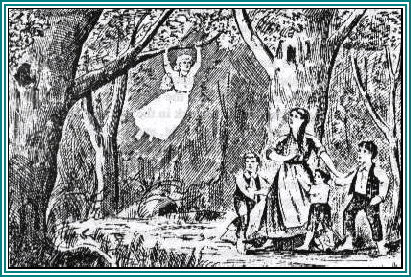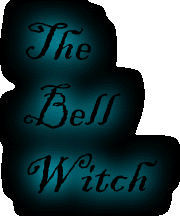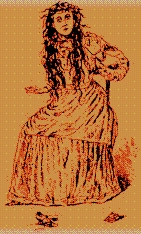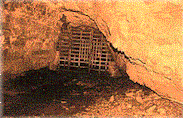
Betsy Bell and her brothers encounter the Bell Witch

Adams, Tennessee, in 1817, was the site of one of the most well-known hauntings in American history – so well known that it eventually caught the attention and then the involvement of a future president of the United States.
Known as The Bell Witch, the strange and often violent poltergeist activity that provoked fear and curiosity in the small farming community has remained unexplained for nearly 200 years, and is the inspiration for many fictional ghost stories, including the recent film, The Blair Witch Project. The facts of The Bell Witch case share little in common with the mythology created for The Blair Witch Project, except they both attracted a great deal of public interest. And because it really happened, The Bell Witch is far scarier.
One early account of The Bell Witch haunting was written in 1886 by historian Albert Virgil Goodpasture in his History of Tennessee. He wrote, in part:
A remarkable occurrence, which attracted wide-spread interest, was connected with the family of John Bell, who settled near what is now Adams Station about 1804. So great was the excitement that people came from hundreds of miles around to witness the manifestations of what was popularly known as the "Bell Witch." This witch was supposed to be some spiritual being having the voice and attributes of a woman. It was invisible to the eye, yet it would hold conversation and even shake hands with certain individuals. The freaks it performed were wonderful and seemingly designed to annoy the family. It would take the sugar from the bowls, spill the milk, take the quilts from the beds, slap and pinch the children, and then laugh at the discomfiture of its victims. At first it was supposed to be a good spirit, but its subsequent acts, together with the curses with which it supplemented its remarks, proved the contrary. A volume might be written concerning the performance of this wonderful being, as they are now described by contemporaries and their descendants. That all this actually occurred will not be disputed, nor will a rational explanation be attempted.
The
Vengeful Ghost
What was the Bell Witch? Like most such stories, certain details vary from
version to version. But the prevailing account is that it was the spirit of
Kate Batts, a mean old neighbor of John Bell who believed she was cheated
by him in a land purchase. On her deathbed, she swore that she would haunt
John Bell and his descendents. The story is picked up by the Guidebook for
Tennessee, published in 1933 by the Federal Government’s Works Project Administration:
Sure enough, tradition says, the Bells were tormented for years by the malicious spirit of Old Kate Batts. John Bell and his favorite daughter Betsy were the principal targets. Toward the other members of the family the witch was either indifferent or, as in the case of Mrs. Bell, friendly. No one ever saw her, but every visitor to the Bell home heard her all too well. Her voice, according to one person who heard it, "spoke at a nerve-racking pitch when displeased, while at other times it sang and spoke in low musical tones.” The spirit of Old Kate led John and Betsy Bell a merry chase. She threw furniture and dishes at them. She pulled their noses, yanked their hair, poked needles into them. She yelled all night to keep them from sleeping, and snatched food from their mouths at mealtime.

Kate Batts, aka Bell Witch
Andrew
Jackson Challenges the Witch
So widely spread was the news about The Bell Witch that people came from hundreds
of miles around hoping to hear the spirit’s shrill voice or witness a manifestation
of its vile temper. When word of the haunting reached Nashville, one of its
most famous citizens, General Andrew Jackson, decided to gather a party of
friends and journey to Adams to investigate. The General, who had earned his
tough reputation in many conflicts with Native Americans, was determined to
confront the phenomenon and either expose it as a hoax or send the spirit
away. A chapter in M. V. Ingram’s 1894 book, An Authenticated History of
the Famous Bell Witch – considered by many to be the best account of the
story – is devoted to Jackson’s visit:
Gen. Jackson’s party came from Nashville with a wagon loaded with a tent, provisions, etc., bent on a good time and much fun investigating the witch. The men were riding on horseback and were following along in the rear of the wagon as they approached near the place, discussing the matter and planning how they were going to do up the witch. Just then, traveling over a smooth level piece of road, the wagon halted and stuck fast. The driver popped his whip, whooped and shouted to the team, and the horses pulled with all of their might, but could not move the wagon an inch. It was dead stuck as if welded to the earth. Gen. Jackson commanded all men to dismount and put their shoulders to the wheels and give the wagon a push, but all in vain; it was no go. The wheels were then taken off, one at a time, and examined and found to be all right, revolving easily on the axles. Gen. Jackson after a few moments thought, realizing that they were in a fix, threw up his hands exclaiming, “By the eternal, boys, it is the witch.” Then came the sound of a sharp metallic voice from the bushes, saying, “All right General, let the wagon move on, I will see you again to-night.” The men in bewildered astonishment looked in every direction to see if they could discover from whence came the strange voice, but could find no explanation to the mystery. The horses then started unexpectedly of their own accord, and the wagon rolled along as light and smoothly as ever.
According to some versions of the story, Jackson did indeed encounter The Bell Witch that night:
Betsy Bell screamed all night from the pinching and slapping she received from the Witch, and Jackson’s covers were ripped off as quickly as he could put them back on, and he had his entire party of men were slapped, pinched and had their hair pulled by the witch until morning, when Jackson and his men decided to hightail it out of Adams. Jackson was later quoted as saying, "I’d rather fight the British in New Orleans than to have to fight the Bell Witch."
The
Death of John Bell
The torment of the Bell house continued for years, culminating in the ghost’s
ultimate act of vengeance upon the man she claimed had cheated her: she took
responsibility for his death. In October 1820, Bell was struck with an illness
while walking to the pigsty of his farm. Some believe that he suffered a stroke,
since thereafter he had difficulty speaking and swallowing. In and out of
bed for several weeks, his health declined. The Tennessee State University
in Nashville, Tennessee, tells this part of the story:
On the morning of December 19, he failed to awake at his regular time. When the family noticed he was sleeping unnaturally, they attempted to arouse him. They discovered Bell was in a stupor and couldn’t be completely awakened. John Jr. went to the medicine cupboard to get his father’s medicine and noticed it was gone with a strange vial in its place. No one claimed to have replaced the medicine with the vial. A doctor was summoned to the house. The witch began taunting that she had place the vial in the medicine cabinet and given Bell a dose of it while he slept. Contents of the vial were tested on a cat and discovered to be highly poisonous. John Bell died on December 20. "Kate" was quiet until after the funeral. After the grave was filled, the witch began singing loudly and joyously. This continued until all friends and family left the grave site.

The Bell Witch Cave
The Bell Witch left the Bell household in 1821, saying that she would return in seven years time. She made good on her promise and “appeared” at the home of John Bell, Jr. where, it is said, she left him with prophecies of future events, including the Civil War, and World Wars I and II. The ghost said it would reappear 107 years later – in 1935 – but if she did, no one in Adams came forward as a witness to it.
Some claim that the spirit still haunts the area. On the property once owned by the Bells is a cave, which has since become known as The Bell Witch Cave, and many locals claim to have seen strange apparitions at the cave and at other spots on the property.
An
Explanation?
A few rational explanations of The Bell Witch phenomena have been offered
over the years. The haunting, they say, was a hoax perpetrated by Richard
Powell, the schoolteacher of Betsy Bell and Joshua Gardner, with whom Betsy
was in love. It seems Powell was deeply in love with the young Betsy and would
do anything to destroy her relationship with Gardner. Through a variety of
pranks, tricks, and with the help of several accomplices, it is theorized
that Powell created all of the “effects” of the ghost to scare Gardner away.
Indeed, Gardner was the target of much of the witch’s violent taunting, and
he eventually did break up with Betsy and left the area. It has never been
satisfactorily explained how Powell achieved all these remarkable effects,
including paralyzing Andrew Jackson’s wagon. But he did come out the winner.
He married Betsy Bell.
Back
to Poltergeists of Distinction
Back to The
Cobra's Ghost